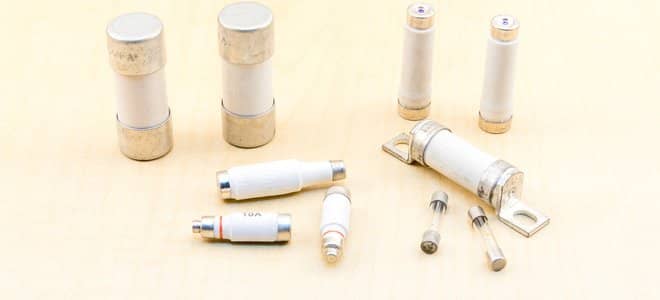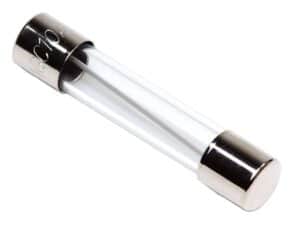In case of a load of large current or short-circuiting, the fuse functions to protect electrical appliances by breaking the circuit. There are various fuses to choose from, each with its size, shape, and material. The most common materials used to produce fuses are ceramic and glass.
The high current going through the fuse melts the fuse element when an accident occurs, such as an overload of the current or short-circuiting, interrupting the flow and breaking the circuit. As a result, the device is protected from being damaged by a surge of current.
The first fuses were just open wires inserted into the circuit to interrupt the current flow when needed. Edison invented the first enclosed fuse in 1890. Since then, the fuse has evolved into a variety of shapes and sizes.
Table of Contents
Types of fuses
The ceramic and the glass fuses serve a similar purpose, but every fuse has its way of working and responding to the current overload.

Every fuse reacts differently to the flow of current and surges; it takes various times to act; it’s critical to select the proper fuse for the circuit it is used in. A faulty fuse may provide zero protection since the melting hasn’t happened in time. Again, it may be oversensitive and frequently blow for no apparent reason.
An FF fuse will typically blow in 1/10 when it takes a standard F fuse to explode for a 500 percent overload, whereas a T fuse can take a longer time to explode.
The construction of fuses
The body of the fuse: The barrel is the body, and each end has a terminal composed of brass.
The fuse element: The fuse element connects these body terminals. The element is made of a single wire or a collection of several wires. To make the fuse react differently, the many wires are placed in diverse ways. Changing the fuses behavior, sand is sometimes added to the body. In most fuses, this is the case.
The benefits of the ceramic fuse

The breaking capacity of a ceramic fuse is essential because it determines how much current the fuse can stop. A ceramic fuse has a larger capacity than any other fuse. It means that ceramic fuses can be utilized in higher-current circuits. Ceramic fuses also protect against overheating.
The Drawbacks of Using a Ceramic Fuse
Ceramic is a sensitive material that is readily shattered. It is a disadvantage since you must handle your fuse with extreme caution.
The pros of the glass fuse

Glass fuses have been around for a long time. They’ve been around for a long time and are a tried and true way of fuse provision. They enable you to do a direct fuse inspection and provide an instant response. They are compact and tiny. Fast-acting glass fuses are available for purchase, providing further protection.
The Drawbacks of Using a Glass Fuse
Glass fuses have a lower breaking point than ceramic fuses, which is their principal disadvantage. When utilizing a glass fuse, there is also the possibility of a temporal delay. It affects the fuse’s dependability.
The differences between the ceramic and the glass fuses
The thermal stability of glass fuses is low and breaks when exposed to high temperatures. Ceramic fuses, on the other hand, are more thermally stable and can resist higher temperatures.
Unlike glass fuses, ceramic fuses are frequently filler filled such as sand, to avoid creating a conducting coating. The fuse element melts and evaporates when a short circuit occurs. The body of a glass fuse heats up continually, causing electric conduction to the film and causing the fuse ineffective.
- The element is visible in a glass fuse, making inspection simple, while the ceramic fuse is not visible (opaque)
- The body of a glass fuse continues to heat up, causing the film to conduct heat energy and render the fuse ineffective.
Summary of the differences in a table
|
Glass fuse |
Ceramic fuse |
| Visible element | The element is opaque |
| Low thermal stability and therefore easily break when exposed to high temperatures. | More thermally stable and can resist higher temperatures |
| It absorbs the heat preventing the fuse from conducting the heat energy | Frequently filled with filler such as the sand to prevent the creation of conducting coating |
| Effective | Ineffective |
Factors to consider before installing a fuse
The following are the different factors that are considered before installing a fuse.
- The breaking capacity.
- The current rating.
- The fuse usage ensures that it is not used at a low voltage than the voltage rating.
To protect your appliances and equipment and decrease the risk of overheating and fire, make sure you select the appropriate fuse. If you’re not sure, consult an electrician.
Frequently asked questions
How do I tell if my thermal fuse is blown?
Most modern appliances contain thermal fuses, which are fire-prevention safety components. A thermal fuse stops the power flow before it reaches the heating element, preventing the item from heating beyond a set maximum temperature. Because a defective heating element might cause an appliance to stop producing heat, you should always test your thermal fuse to check that it is genuinely blown before replacing it.
Most modern appliances contain thermal fuses, which are fire-prevention safety components. Because a defective heating element might cause an appliance to stop producing heat, you should always test your thermal fuse to check that it is genuinely blown before replacing it.
Before attempting to troubleshoot the thermal fuse, unplug the equipment from its power supply. Before proceeding on to Step 2, make sure the appliance is entirely de-energized or de-gassed.
To find out where the thermal fuse is situated on your appliance, see the user manual. If you can’t locate this information in your user manual, contact the manufacturer. To reach the thermal fuse in your appliance, remove the relevant panel. Remove the four corner screws that hold the panel in place to gain access to the thermal fuses behind the back appliance panel. Thermal fuses located behind the bottom kick appliance panel are accessed by pressing on the metal clips at the top of the panel with a putty knife until they release.
- To reach the thermal fuse in your appliance, remove the relevant panel.
- Thermal fuses located behind the bottom kick appliance panel are accessed by pressing on the metal clips at the top of the panel with a putty knife until they release.
Look for the thermal fuse among the exposed appliance components. Look for a piece of white plastic about 1 inch long with two wires attached. Pull the wires from the thermal fuse gently to disconnect them.
To turn on your digital multimeter, press the corresponding button. Set it to read Rx1 resistance by turning the control dial. Touch the left multimeter leads to the thermal fuse’s left side, and the right one leads to the fuse’s right side. Keep an eye on the needle; if it doesn’t move, it’s a sign of a blown thermal fuse.
Conclusion
You now have a better understanding of the differences, benefits, and drawbacks of both glass and ceramic fuses, making it easier to choose which to employ. Look over the list to see which items will be most helpful to you, and then make your purchase.
To protect your appliances and equipment and decrease the risk of overheating and fire, make sure you select the appropriate fuse. If you’re not sure, consult an electrician.
